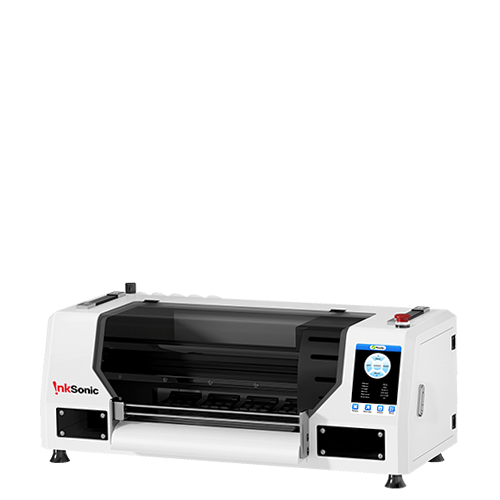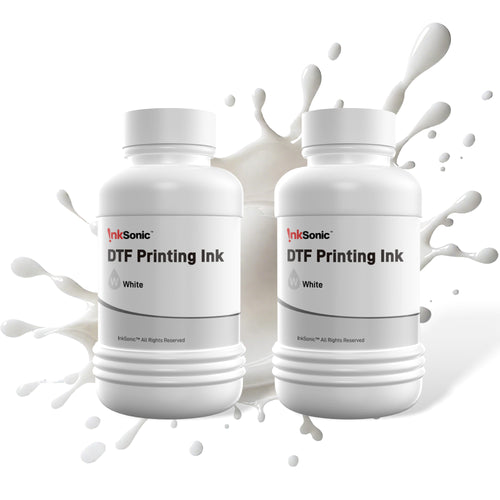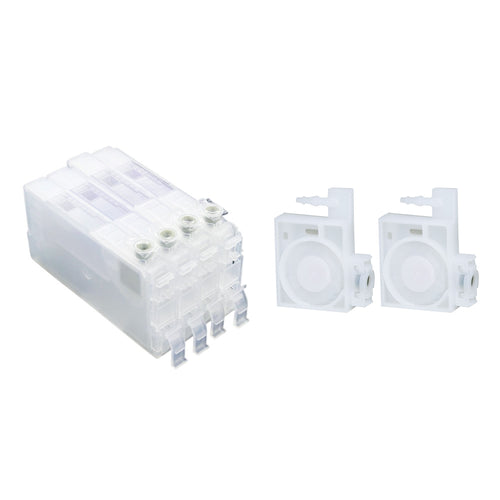Are you dreaming of having your own designed clothes and accessories? Want to bring your creations to life? With DTF printing, you can! It’s a fantastic way to add a personal touch to your favorite T-shirt, shoes, tote bag, and hoodies. But what is it, and how do you use a DTF printer?
What Is DTF Printing?

DTF, or “Direct-to-Fabric,” is a method that prints the design onto a special film. Once printed, an adhesive is used to apply the design and transfer it to the fabric using a heat press. It works like magic but with ink!
What Sets a DTF Printer Apart From Its Competitors?

DTF printing is becoming a popular choice over traditional printing for the following reasons:
- Unleash Your Creativity – Unlike pre-made layouts, DTF lets you create your design, whether simple or complex. Logos, pictures, artwork—the sky is the limit!
- Works on (Almost) Anything – Some printing machines only work on specific fabrics. You won’t have to worry about the textile or color with direct-to-fabric printing. DTF printers work well on cotton, polyester, silk, and even dark-colored fabrics! This flexibility allows you to personalize almost anything in your wardrobe or home.
- Durable Designs – Designs produced by other printing methods may crack or fade over time—not with DTF printing! The designs printed through this tactic don’t crack or fade, so rest assured the layout lasts.
Tools to Use for DTF Printing

Before designing your masterpiece, you need to gear up first! Here are the tools you’ll need for direct-to-fabric printing:
- DTF Printer – This is your workhorse. It uses unique inks to produce designs directly to a special film.
- Heat Press – As the name implies, this tool uses heat and pressure to stick the design onto the fabric permanently.
- DTF Film – It’s a sheet where your design gets printed. It’s specifically designed to work with DTF inks and powders.
- DTF Powder – This isn’t any ordinary powder; it works like glue. It sticks the layout permanently to the material.
- DTF Ink – Available in a kaleidoscope of colors, it brings your design to life.
- DTF Software – It’s a program installed on your computer that lets you create fantastic artwork.
One important thing to remember when it comes to films, powders, and inks is that many options are available. Some work on specific materials or layouts, so choose the right supplies for your projects. Don’t worry about your budget—there are options for every wallet size.
Creating Your Masterpiece

Here comes the fun part – creating your designs! You’ll need design software for this; your chosen program will depend on your comfort level. Popular choices are Adobe Illustrator and Photoshop. These design programs let you use your creative juice, whether you’re drawing by hand or using digital tools.
But there are free, user-friendly options, too! Some popular options include GIMP, Canva, and Inkscape. Whether you want to take advantage of the free software or get a premium design program, it’s your choice.
When designing for DTF printing, there are a few things to keep in mind:
Design for the Fabric
Consider the type of material you’re printing on. If you’re working on a dark-colored material, the design should have good contrast to make it stand out. Some designs might need a white “under base” printed first to make certain colors pop out on dark textiles.
Size Matters
Ensure the design is the right size for the item you’re working on. You don’t want a tiny logo on an oversized T-shirt or a colossal pattern that gets cut off on a tote bag. Think carefully about where to print the design and size it accordingly.
Embrace Bold Colors
Since the layout will be transferred to the fabric, choose bright, clear colors for maximum impact. A DTF printer can handle intricate color blends and gradients, so don’t be afraid to express yourself with bold colors.
Be the Poster
Your design should have a clear and well-defined image that grabs attention. It’s like creating a design for a poster—except that you’re making it for your apparel. Strike a balance between an eye-catching image and something that resonates with your overall style and vibe.
The DTF Printing Process – From Design to Fabric

Once your design is ready, it’s time to transform your digital artwork into a physical masterpiece! Here’s how to use a DTF printer for beginners:
The Printing Process Begins
Your printer takes your design and carefully prints it onto the DTF film, but with a twist—it prints the image in reverse! It’s like a mirror image. When the design gets transferred to the fabric, it must be the right way around.
Put the Powder On
This step is where things get a little bit messy but fun. Once the ink is printed, sprinkle the powder all over the wet design on your film. Ensure you cover the entire layout, then shake off any excess powder to keep things neat.
Heat It Up
It’s time to bring the heat! You have two options to heat your design: the heat press and the oven.
- Heat Press – It’s the right tool for this job. A heat press has a large, flat surface and applies heat and pressure evenly, which is crucial for a flawless design transfer. Place the powdered film onto the heat press and press it down for the recommended time and temperature.
- Oven – If you don’t have a heat press yet, you may use a regular oven as an alternative, but use it cautiously. The oven works for smaller designs. Place the film on a baking sheet lined with parchment paper. Follow the temperature and instructions for your special DTF film.
Remember, the heat melts the powder and turns it into a strong adhesive. Once transferred onto the fabric, it creates a durable bond that locks the design permanently.
Transferring Your Design to the Garment

It’s the moment you've been waiting for – finally bringing your design to life on your chosen fabric. Here’s a step-by-step guide to transferring the design to the garment:
Prepare the Fabric
Your fabric is the canvas for your masterpiece! Start by selecting a t-shirt, hoodie, tote bag, or any other item you want to personalize. Pre-washing and drying the fabric removes any dust, lint, or other particles that could interfere with the transfer process. It also pre-shrinks the fabric, so your design won't distort after the first wash.
Press the Design
Carefully place the DTF film with your design facing down onto the fabric. Make sure it's positioned exactly where you want it. Then, use the heat press to apply heat and pressure.
The Big Reveal
The anticipation is killing you! Depending on your DTF film, you might need to follow one of two procedures:
- Hot Peel – Some films require you to immediately peel away the backing sheet while the design is still hot.
- Cold Peel – Other films need to cool down completely before removing the backing.
Once you peel away the film, the excitement builds! Your awesome design will be perfectly transferred onto the fabric, ready to rock and roll!
DTF Printing – Top Tips and Tricks for Stunning Results

With a bit of practice, DTF printing is incredibly rewarding. Here are some expert tips and tricks to make your DTF journey smooth and successful:
Wash and Wear Smart
Always wash and dry your fabric garments before printing to remove any dust or residue that might affect the design transfer.
Experimentation Is Key
Don't be afraid to experiment with different designs, fabrics, and colors to unlock your creativity. Each combination can offer unique outcomes, so don't hesitate to try new things!
Practice Makes Perfect
As with any new skill, practice is key. The more you print and transfer designs, the better you'll understand the following:
- Temperature and pressure – How to adjust your heat press settings for different fabrics and film types.
- Materials – Which fabrics and DTF supplies work best for your style of designs.
Find Your Style
Knowledge is your best friend, and there are tons of fantastic resources to learn everything about DTF printing:
- YouTube Tutorials – Visual guides are perfect for understanding processes. Watch and learn from experts sharing their tips.
- Online Forums – Connect with other DTF enthusiasts, ask questions, and share your successes.
- Experiment! Guided experimentation will teach you more than any textbook. Test how different design choices work on various fabrics.
Maintenance and Troubleshooting

Even the best DTF printers can sometimes encounter a little hiccup. Here are some common issues and what you can do about them:
Design Won’t Stick
If your design isn't transferring correctly onto the fabric, focus on three key areas. First, ensure your heat press reaches the correct temperature required for your specific DTF film.
Second, verify that you're applying sufficient and even pressure during the transfer process. Insufficient pressure can prevent the design from fully adhering. Finally, remember that not every fabric works well with DTF printing. Experiment with different textiles to find the best results for your designs.
Faded Design
If your colors look dull, try switching to brighter inks or choosing a more compatible fabric for brighter colors.
Printer Problems
If your DTF printer displays an error message or encounters a jam, double-check the connections. Ensure it’s properly connected to the computer or network and all cables are secure. Next, verify that all the ink cartridges have sufficient ink levels; low ink can sometimes cause unexpected issues. Finally, consult your printer's manual for specific troubleshooting instructions tailored to your model, as error codes and solutions can vary.
Conclusion
DTF printing is a fantastic way to explore your creativity, personalize your belongings, and maybe even start your own customized clothing business! Just keep designing, printing, and, most importantly – have fun bringing your unique ideas to life!

































